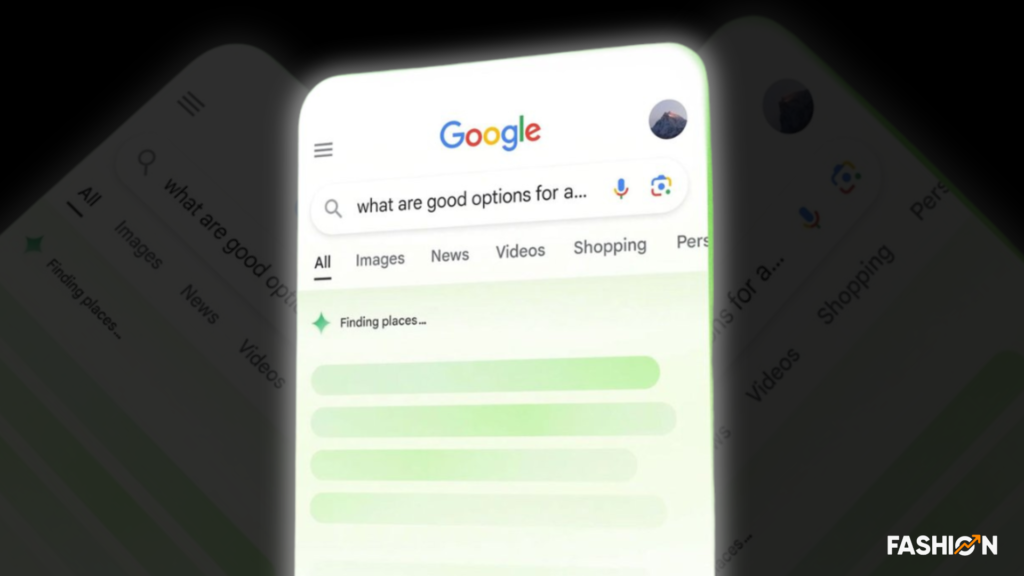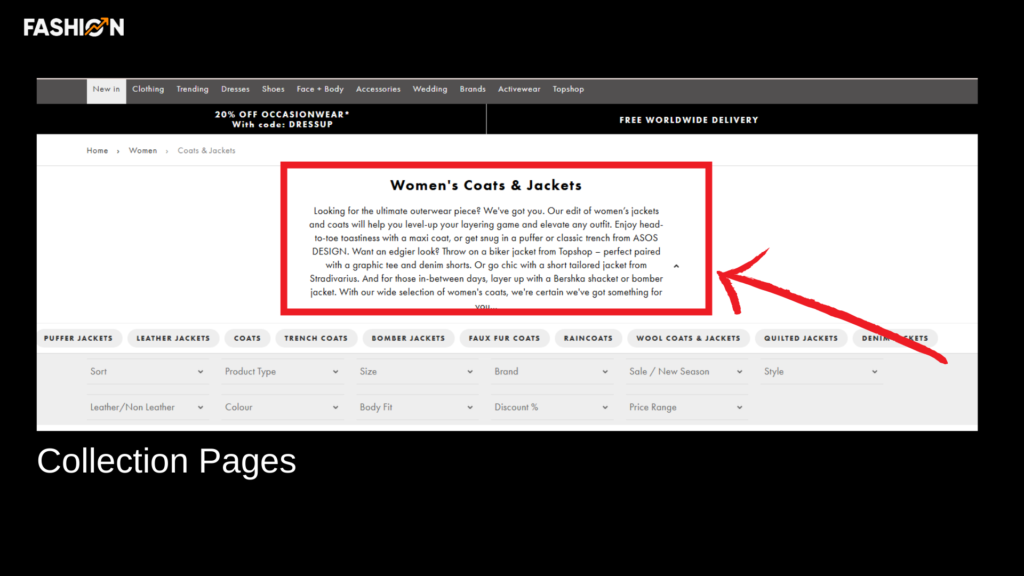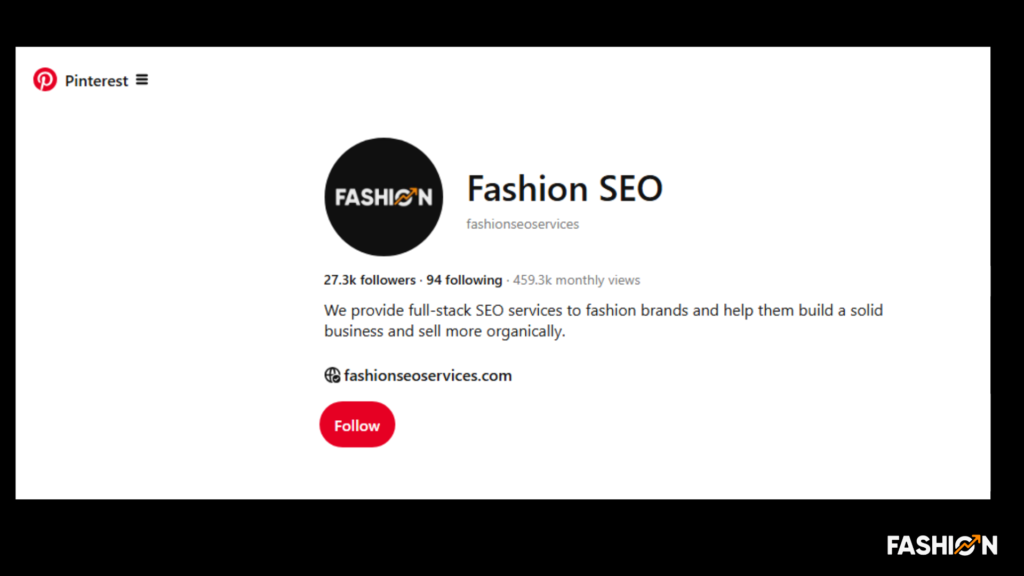Sometimes organic traffic feels impossible. One day, your store ranks; the next, it’s buried under AI-generated search results. It’s slow and tests your nerves. And if you’re following the last year’s fashion SEO advice, it’s almost useless. The game has changed, and now AIOs are stealing the clicks and TikTok and Pinterest drive fashion trends.
If you’re running a fashion e-commerce store, you need fundamental strategies that work in 2025…not generic “write good content” tips. You need AI-resistant content, visual search optimization, and smarter keyword targeting.
This guide provides 10 proven SEO tactics that we tested and implemented on our client’s site and saw significant improvements in organic traffic.
So, let’s get straight to them.
- Optimize for AI Overviews & AI-Driven Search Results
Google’s AI Overviews pull answers directly from websites, which, unfortunately, reduces traditional organic clicks. If your content isn’t optimized, your store could get ignored…even if you rank.

But don’t panic, here’s how to optimize for AIOs
- Write concise, structured answers to fashion-related queries.
AI Overviews prioritize clear, direct responses. Instead of long-winded explanations, format content with punchy, fact-based answers followed by detailed insights. Example:
Bad Way:
- “Many factors affect denim quality, such as cotton type, weaving technique, and dyeing process. Premium brands use…”
Good Way:
- “The best denim brands in 2025 use organic cotton, selvedge weaving, and eco-friendly dyes. Examples: Levi’s, Nudie Jeans, and Everlane.”
- Use structured data markup (FAQ, How-To, Product Schema).
Structured data is important for SEO. If your pages lack FAQ or How-To schema, you’re losing visibility. Add schema for:
- Product pages (detailed descriptions, availability, pricing)
- FAQ sections (answering common fashion-related questions)
- How-To guides (e.g., “How to style oversized blazers in 2025”)
- Boost E-E-A-T (Experience, Expertise, Authority, Trustworthiness).
AI prioritizes content from credible sources.
Show your brand’s expertise through:
- Author bios showcasing fashion industry credentials
- Case studies & insights from real fashion trends and sustainability efforts
- Citations & links to authoritative fashion sources
- Leverage branded queries & entity-based SEO.
AI search understands brand relationships. Optimize for your store’s name + product category and build backlinks with consistent brand mentions.
- Provide first-hand insights.
AI favors original content. Share fashion reports, trend analysis, or expert quotes to boost visibility. For example, If AI Overviews pulls from your sustainability report, your brand gets featured as the go-to source.
READ: How to Optimize Product Descriptions for SEO to Get More Sales
- Leverage Long-Tail & Conversational Keywords Aligned with LLM-Based Search
AI-powered search engines like ChatGPT, Perplexity, and Gemini are changing how users find fashion products. Shoppers now ask detailed, conversational questions rather than simple keywords. AI won’t pull your pages if your content doesn’t match these queries.
Here’s how to get it right;
- Use intent-driven, long-tail keyword clusters.
Forget broad terms like “summer dresses.” AI understands search intent and prefers natural, niche-specific queries.

Optimize for:
- Descriptive phrases → “Best breathable summer dresses for humid weather”
- Comparisons → “[product A] vs. [product B] for [purpose]…what’s better?”
- Affordability-focused searches → “Luxury handbags under $500 with best resale value”
- Target question-based queries.
AI Overviews and LLMs favor questions that match how people talk.
Examples:
- “What’s the best sustainable denim brand for petite women?”
- “Which sneakers go best with wide-leg jeans?”
- “Where can I buy vintage leather jackets in NYC?”
- Track zero-click search trends.
Many users never click through…they get answers directly in AI search.
To capture traffic, adjust your content to provide:
- “Next-step” actions → Instead of just answering “What is a capsule wardrobe?”, include “How to build one + where to shop.”
- Comparison-style content → “Best eco-friendly fashion brands: Features, price, and quality breakdown.”
- Create High-Value AI-Resistant Content (First-Person Insights & Trend Forecasts)
If your fashion blog repeats the same recycled “Top 10 Summer Dresses” list, AI will summarize it…without sending you traffic. Google now prioritizes original insights, expert commentary, and unique data that AI can’t easily replicate.
You can do it easily. Here’s how;
- Publish original fashion insights & exclusive trend forecasts.
AI scrapes existing data but can’t predict the future…you can.
Stay ahead by publishing:
- Fashion trend reports based on your data (e.g., “Color trends for Fall 2025 based on last year’s bestsellers”)
- Exclusive interviews with designers, stylists, or industry insiders
- Case studies on real customers (e.g., “How sustainable denim brands are reshaping fast fashion”)
READ: How to Optimize Fashion Websites for Search Engines in 2025
- Use proprietary data to stand out.
Google favors unique, data-backed content.
Conduct and publish:
- Polls & surveys (e.g., “We asked 1,000 shoppers: What makes them choose one handbag over another?”)
- Internal sales trends (e.g., “Our most purchased dress style in 2025? The slip dress is back.”)
- Heatmaps & customer behavior insights (e.g., “80% of shoppers browse on mobile, but checkout on desktop”)
- Integrate brand storytelling & ethical fashion.
Consumers (and search engines) value authenticity.
Share behind-the-scenes content:
- Your brand’s journey (e.g., “Why we stopped using synthetic fabrics in 2024”)
- Sustainability efforts (e.g., “How our recycled leather jackets save 5,000 gallons of water per piece”)
- Transparent sourcing stories (e.g., “Meet the artisans behind our handmade jewelry collection”)
- Use interactive & AI-assisted content.
Static blog posts won’t cut it.
Keep users engaged with:
- Quizzes (e.g., “Find Your Perfect Capsule Wardrobe”)
- Outfit builders (mix-and-match clothing pieces)
- AI-assisted personal styling (use AI to recommend outfits based on user preferences)
The purpose is to make your valuable in a way that AI can’t replicate.
- Optimize Category & Product Pages for Search & AI Discovery
Most fashion e-commerce traffic comes from category and product pages—not blog posts. But if your category pages aren’t optimized, Google won’t surface them in AI-driven searches. Worse, weak product pages get buried under AI-generated recommendations.
Here’s how we optimize category and product pages;
- Implement hyper-relevant internal linking for topical authority.
Google ranks your content higher if it is well-connected.
Instead of random links, build:
- Clustered categories (e.g., link “Vegan Leather Boots” to “Sustainable Handbags”)
- Smart internal links from blogs to product pages (e.g., “Best Linen Dresses” → Linen Dress Collection)
- AI-friendly navigation (make sure categories connect logically so AI search understands your site structure)
- Optimize category pages for commercial-intent keywords.

Shoppers search with intent. Don’t just name a category “Dresses”—optimize it for search & AI by using:
- Long-tail, purchase-driven keywords (e.g., “Luxury wedding guest dresses under $300”)
- Sale-focused terms (e.g., “Summer maxi dresses on sale 2025”)
- Modifiers AI understands (e.g., “Best-rated linen dresses for beach vacations”)
- Use unique product descriptions (avoid manufacturer duplicates).
AI ignores duplicate content. If you copy-paste the manufacturer’s description, your product won’t rank.
Instead:
- Rewrite descriptions with detailed, benefit-driven copy
- Include fabric details, fit guidance, and styling suggestions
- Answer common buyer questions in a structured FAQ format
- Integrate rich media for better engagement.
Google and AI prioritize interactive experiences.
Upgrade your product pages with:
- Short product videos (e.g., “How this dress moves when you walk”)
- User-generated content (UGC) (customer photos & reviews)
- 3D product views (360-degree rotations to show details)
- Improve page load speed & mobile UX for Core Web Vitals.
Slow, clunky pages kill rankings.

Prioritize:
- Image compression (without losing quality)
- Lazy loading (so images don’t slow down page speed)
- Mobile-first design (AI prefers fast, responsive pages)
READ: Why Fashion Brands Need Local SEO To Outrank Competitors in 2025?
- Master Topical Authority with the Hub & Spoke Content Model
Google no longer ranks thin, scattered content. It favors brands that demonstrate deep expertise within a niche. This is where the Hub & Spoke content model gives you a competitive edge. By structuring your content around a central hub (pillar page) and linking to detailed spoke articles, you build topical authority.
Here’s how to do it;
- Create pillar pages that establish authority.
Think of a pillar page as the ultimate resource for a niche topic in your industry.
Example:
Hub: “The Ultimate Guide to Luxury Sustainable Fashion in 2025”
Spokes:
- “Best Ethical Handbag Brands Under $500”
- “What Makes a Brand Truly Sustainable? A Breakdown of Certifications”
- “Luxury vs. Fast Fashion: The Hidden Costs of Cheap Clothing”
Your hub page should be a go-to resource, constantly updated with fresh insights and linked to all relevant spokes.
- Cover all subtopics within your niche.
Don’t just write random fashion content. Instead, own a specific sub-niche like:
- Sustainable fashion
- Minimalist wardrobes
- High-end streetwear
By covering every angle of your niche, Google and AI-driven search engines recognize your expertise and rank you higher.
- Build seasonal evergreen hubs.
Some fashion topics repeat every year. Take advantage of this! Instead of creating new pages annually, build one evergreen hub that gets updated:
- “Best Winter Coats for 2025” → Rename to “Best Winter Coats: Updated for 2026”
- “Summer Wedding Guest Dresses 2024” → Update to 2025 & beyond
This strategy preserves link equity and keeps your content ranking longer.
- Use strategic internal linking.
Every spoke article should link back to the hub…and vice versa. This signals relevance to search engines, strengthening your topical authority.
With this model, AI Overviews and Google will favor your content over competitors with disorganized blog structures.
READ: SEO for Fashion E-Commerce: A-Z Guide for 2025
- Increase Click-Through Rate (CTR) with AI-Optimized Meta Titles & Descriptions
AI-powered search often answers questions directly, reducing traditional clicks. But that doesn’t mean organic CTR is dead. Users still click when your meta title stands out. Optimizing your meta titles and descriptions for AI search is the new game changer.
- A/B test curiosity-driven meta titles.
Titles that spark curiosity outperform generic ones. Compare these:
Bad Way:
- “Best Sneakers for 2025” → Boring, predictable
Good Way:
- “10 Sneakers That Will Instantly Upgrade Your 2025 Wardrobe” → Compelling
Try A/B testing different versions to see what gets the best click-through rates.
- Use power words & numbers.
Numbers and powerful words grab attention faster.
Examples:
- “7 Timeless Fashion Trends That Never Go Out of Style”
- “10 Must-Have Sneakers That Elevate Your Look in 2025”
- “The Only Handbag You’ll Ever Need (And Why It’s Worth It)”
- Include brand mentions & trust signals.
Adding trust-building elements increases credibility:
- “Recommended by Vogue Editors: 5 Luxury Fashion Trends to Watch”
- “As Seen on Gigi Hadid: 8 Affordable Streetwear Staples”
- “NYC Stylists Swear By These 6 Budget-Friendly Fall Outfits”
- Monitor AI-driven SERP changes & adjust.
Google constantly experiments with SGE snippets (Search Generative Experience) and AI Overviews.
Stay ahead by:
- Watching which meta descriptions Google rewrites in AI Overviews
- Tracking zero-click search trends (which queries are fully answered in AI search?)
READ: 5 Local SEO Strategies Every Boutique Owner Should Know
- Strengthen Brand SEO with Influencer & UGC Strategies
Fashion SEO is also heavenly dependent on brand signals, trust, and authority. Google and AI-driven search engines prioritize brands with strong online presence, influencer mentions, and user engagement.
So here’s how you can strengthen your brand;
- Partner with micro-influencers & fashion bloggers for SEO-rich backlinks.
Forget generic/paid/robotic PR. Google values natural backlinks from niche-relevant sources.
Collaborate with:
- Micro-influencers (10K-100K followers) who have highly engaged audiences
- Fashion bloggers with authority in your niche
- YouTube/TikTok creators who review and recommend products organically
This builds brand authority, attracts referral traffic, and boosts search rankings through contextually relevant backlinks.
- Encourage user-generated content (UGC) for SEO & social proof.
Customers trust real people more than ads.
Use these UGC tactics:
- Create hashtag challenges (e.g., #MySustainableStyle) to encourage user participation.
- Feature UGC reviews & testimonials on product pages—Google values fresh, real-user content.
- Launch Instagram & TikTok “wear it your way” campaigns, encouraging users to style your products creatively.
More UGC = more branded searches, more engagement, and higher trust signals in Google’s ranking system.
- Embed shoppable UGC & social media posts into product pages.
Static product images are outdated. Instead, embed real user photos & influencer videos directly into product pages.
For example:
- Nike integrates Instagram reels of customers styling their sneakers directly on the product page.
- Fashion brands add TikTok reviews as product visuals to boost conversions.
- Google notices engagement metrics. The longer users stay on your page, the better your rankings.
- Optimize press mentions & PR content for organic brand growth.
Google favors brands featured in authoritative sources. Secure fashion magazine features, industry interviews, and guest posts to:
- Boost credibility in AI-generated search results.
- Strengthen branded search queries (Google associates you with trusted sources).
- Increase referral traffic from fashion-related news outlets.
By blending SEO with influencer collaborations & UGC, you solidify your brand’s presence in AI-driven search landscapes.
READ: How to Choose the Right Fashion SEO Agency (With Checklist)
- Dominate Video & Visual Search (Google Lens, TikTok SEO, Pinterest Search)
Fashion is a visual-first industry, and Google knows it. Text-based search is shifting to image & video-based queries. Users now search by uploading images (Google Lens) or using TikTok & Pinterest as discovery platforms. If your products aren’t optimized for visual search, you’re losing traffic.

Here’s how you can leverage this;
- Optimize product images for Google Lens & AI-powered image search.
Google Lens lets users search for similar fashion items by uploading a photo.
To rank in these results:
- Use descriptive, keyword-rich alt text (e.g., “white leather ankle boots with gold buckle”).
- Rename image files with SEO-friendly names (e.g., black-satin-midi-dress-2025.jpg instead of IMG12345.jpg).
Tag images with product metadata (brand, material, price, availability).
- Publish short-form fashion explainer videos on YouTube & TikTok (optimized for search).
TikTok and YouTube Shorts are fashion search engines in disguise.
To rank higher:
- Use keyword-rich video titles & descriptions (e.g., “Best Affordable Streetwear Outfits Under $100”).
- Add closed captions & subtitles (Google indexes video text for search results).
- Embed videos into your blog & product pages to boost engagement and dwell time.
- Use Pinterest SEO for product discovery.
Pinterest is the best visual search engine. To get your fashion products discovered:
- Create keyword-rich pin descriptions (e.g., “Chic boho maxi dress for summer vacations 2025”).
- Optimize board names for searchability (e.g., “Sustainable Fashion Finds Under $50”).
- Link Pinterest posts to category & product pages to drive traffic directly to your store.
- Monitor & adapt to visual search trends.
Stay ahead by:
- Tracking Google Lens trends for product searches.
- Analyzing Pinterest and TikTok search behaviors (which products go viral?).
- Experimenting with AI-generated outfit previews & interactive fashion try-ons (Google is testing AR shopping features).
Fashion brands that master video & visual search will dominate AI-driven discovery platforms.
Final Takeaway: Future-Proof Your Fashion SEO Strategy
SEO in the fashion industry has changed immensely in the past 1-2 years. Brands that adapt to the latest shifts happening will outperform competitors, drive more organic traffic, and boost conversions.
By implementing these strategies you’ll stay ahead of algorithm changes and secure long-term visibility.
If you need experts guidance check out our fashion SEO services to optimize your brand for AI-powered search.

